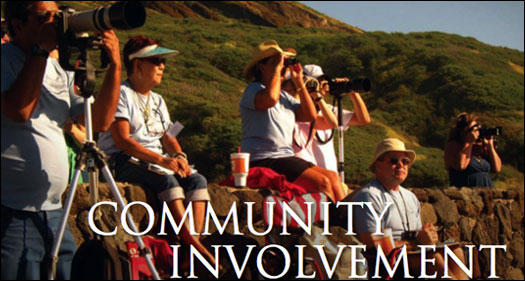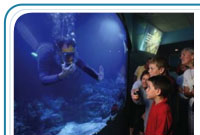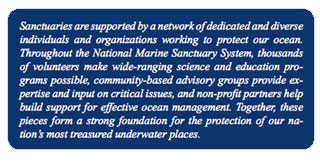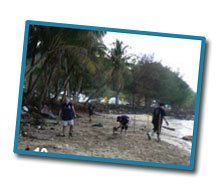
 |
 |  |
|
Sanctuaries Provide A "NOAA Storefront" in Communities
|
 hrough shared assets and community partnerships, sanctuaries showcase NOAA's mission. The sanctuary system continues to expand its
visitor facilities - the places where the public
learns about sanctuaries and the rest of NOAA.
These facilities include seven sanctuary visitor
centers that reached more than 190,000 visitors
in 2009 alone. Sanctuary exhibits in aquariums
and museums around the nation reach millions
more. Last year also marked the opening of the
new Sanctuary Learning Center in Kihei, Maui,
at the Hawaiian Islands Humpback Whale National Marine Sanctuary. hrough shared assets and community partnerships, sanctuaries showcase NOAA's mission. The sanctuary system continues to expand its
visitor facilities - the places where the public
learns about sanctuaries and the rest of NOAA.
These facilities include seven sanctuary visitor
centers that reached more than 190,000 visitors
in 2009 alone. Sanctuary exhibits in aquariums
and museums around the nation reach millions
more. Last year also marked the opening of the
new Sanctuary Learning Center in Kihei, Maui,
at the Hawaiian Islands Humpback Whale National Marine Sanctuary.
In addition to facilities, sanctuaries are the places where other NOAA assets and expertise are
focused. The West Coast Region benefits from
a Twin Otter aircraft, operated by NOAA's Aircraft Operations Center. The aircraft maximizes the ability to service the West Coast national
marine sanctuaries for resource protection,
scientific surveys and enforcement, and to support other NOAA priorities. In partnership with
NOAA's Great Lakes Environmental Research
Laboratory, Thunder Bay National Marine
Sanctuary also acquired the 50-foot research
vessel Storm, which will provide a platform for
archaeological research, remote sensing and
mooring buoy deployment. The R/V Storm has
been converted to a petroleum-free vessel and
uses 100-percent soy biodiesel for engine fuel.
|
|
 |

Heart of the Sanctuary System: Volunteers Make a Difference
 Every year, thousands of citizens volunteer to serve throughout the National Marine Sanctuary System, helping make many of the sanctuaries' most successful programs a reality.
Two such programs that rely heavily on volunteer support are the Channel Islands Naturalist Corps and the Sanctuary Ocean Count. The Naturalist Corps, which conducts education and science activities like public outreach and whale identification at Channel Islands
National Marine Sanctuary, received more than 25,000 hours from 135 trained volunteers
in 2009. Last year also marked the 14th annual Sanctuary Ocean Count at the Hawaiian
Islands Humpback Whale National Marine Sanctuary, a project that enlists local residents
and tourists to count and observe humpback whales every year. This popular outreach effort
continued to grow in 2009 as more than 1,500 volunteers on the islands of Hawaii, Kauai
and Oahu donated over 11,000 hours of their time, increasing their appreciation for the
ocean while contributing to scientific whale research. Every year, thousands of citizens volunteer to serve throughout the National Marine Sanctuary System, helping make many of the sanctuaries' most successful programs a reality.
Two such programs that rely heavily on volunteer support are the Channel Islands Naturalist Corps and the Sanctuary Ocean Count. The Naturalist Corps, which conducts education and science activities like public outreach and whale identification at Channel Islands
National Marine Sanctuary, received more than 25,000 hours from 135 trained volunteers
in 2009. Last year also marked the 14th annual Sanctuary Ocean Count at the Hawaiian
Islands Humpback Whale National Marine Sanctuary, a project that enlists local residents
and tourists to count and observe humpback whales every year. This popular outreach effort
continued to grow in 2009 as more than 1,500 volunteers on the islands of Hawaii, Kauai
and Oahu donated over 11,000 hours of their time, increasing their appreciation for the
ocean while contributing to scientific whale research.
Advisory Council Actions Focus on Ocean Acidification
Hundreds of people around the nation played an integral role in the management
of national marine sanctuaries in 2009 through participation in sanctuary advisory
councils. Advisory councils provide a way for local community members to
provide recommendations to the sanctuary superintendent and help guide sanctuary
activities at each of the 14 sites managed by the Office of National Marine Sanctuaries. Across the sites, more than 740 council and working group members volunteered over 16,000 hours of their time last year. The topic of ocean acidification galvanized councils, with 13 councils taking action by educating council members on the topic, passing resolutions and making recommendations recognizing the threat it poses to sanctuary resources, and urging NOAA to take action at the national, regional and local level.
Sanctuaries Aid in Natural Disaster Recovery Efforts
 Recently, nature has tested the readiness of two sites in the National Marine
Sanctuary System. On Sept. 29, 2009, an 8.3 magnitude earthquake struck
190 kilometers southwest of American Samoa and generated a tsunami that
devastated shorelines throughout the island, where the offices of Fagatele Bay
National Marine Sanctuary are located. One year prior, Hurricane Ike passed
directly over Flower Garden Banks National Marine Sanctuary, leaving a trail of
smashed corals and shifted sand before making landfall at Galveston Island,
home to the sanctuary office and staff. While the primary concern in each of
these disasters was for the safety of the site staff and their families, following
both events sanctuary vessels and staff were deployed to assist local partners
with recovery efforts and damage assessments of sanctuary resources. Staff
members from the sanctuary system continue to work with other parts of NOAA
to identify needs and support the recovery process wherever possible. Recently, nature has tested the readiness of two sites in the National Marine
Sanctuary System. On Sept. 29, 2009, an 8.3 magnitude earthquake struck
190 kilometers southwest of American Samoa and generated a tsunami that
devastated shorelines throughout the island, where the offices of Fagatele Bay
National Marine Sanctuary are located. One year prior, Hurricane Ike passed
directly over Flower Garden Banks National Marine Sanctuary, leaving a trail of
smashed corals and shifted sand before making landfall at Galveston Island,
home to the sanctuary office and staff. While the primary concern in each of
these disasters was for the safety of the site staff and their families, following
both events sanctuary vessels and staff were deployed to assist local partners
with recovery efforts and damage assessments of sanctuary resources. Staff
members from the sanctuary system continue to work with other parts of NOAA
to identify needs and support the recovery process wherever possible.
Monterey Bay Programs celebrate 10 Years of conservationcraft Operations Center.
Monterey Bay National Marine Sanctuary's Water Quality Protection Program
had much to celebrate in 2009. Both the Snapshot Day and First Flush water
quality monitoring programs have provided resource managers with 10 years
of data about the health of local streams and the pollutant concentrations in
storm water runoff. With the help of thousands of volunteers and partners,
these important programs have established a baseline of information about
water flowing from our watersheds into the sanctuary. In addition, the Agriculture Water Quality Alliance celebrated 10 years of collaborative conservation
efforts. This unique regional partnership brings together farmers, ranchers, resource conservation agencies, researchers and environmental organizations
to protect the health of sanctuary waters. Farmers and ranchers of the central
coast are setting an example for other regions by showing that economically
viable agriculture is compatible with environmental protection.
|



